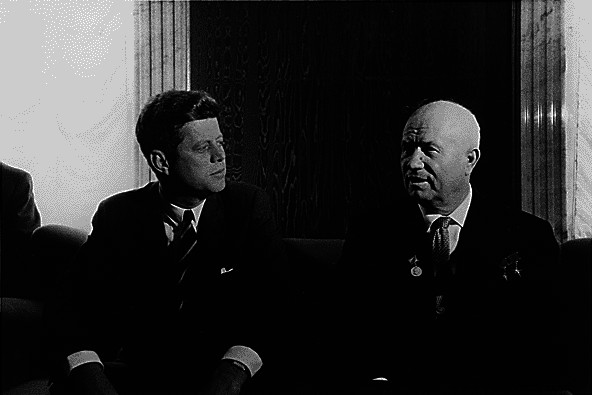- The Grand Alliance disappeared at the end of the Second World War. The USSR kept under its control the countries of Eastern Europe that it had liberated and, in 1946, Churchill warned the world against the iron curtain that had fallen on Europe. The world is now divided into two camps with competing ideologies, the Western bloc behind the United States and the Eastern bloc behind the USSR. In a very tense international context, they will face each other indirectly for nearly 50 years.
1947 - 1991

Characters
Harry S. Truman
Dwight D. Eisenhower
John F. Kennedy
Richard M. Nixon
Jimmy Carter
Ronald W. Reagan
George Bush
Joseph Stalin
Nikita Khrushchev
Leonid Brezhnev
Mikhail Gorbachev
Procedure
climbing
In 1947, Truman implemented his doctrine of containment by launching the Marshall Plan in Europe, to which Stalin responded the same year with the Zhdanov doctrine in the USSR.
In June 1948, the occupying forces having been unable to reach an agreement on the occupation of Berlin, Stalin launched the blockade of West Berlin:it would last a year, the city subsisting thanks to the American airlift.
In 1949, the allies signed the North Atlantic Treaty (NATO), an alliance making it possible to face the USSR. In 1955, the USSR will do the same with the Warsaw Pact.
The same year, RFA and RDA are recognized as two separate states.
In 1949 Mao came to power in China, strengthening the Eastern bloc. He supports the Communist government of North Korea in its war against South Korea, an ally of the United States. In 1950, the Korean War began, in which the coalitions of the two blocs clashed for three years:the Cold War became military and global.
The death of Stalin, on March 5, 1953, led to the armistice of Pan Mun Jon, beginning the "détente".
The “relaxation”
The USSR has the A-bomb, so it is more confident against the United States. In 1954, the two countries met at the Geneva conference with France and Great Britain to negotiate peace and international security:we became aware of the nuclear danger.
Khrushchev develops the idea of a peaceful coexistence between the two blocs:thus, NATO does not intervene during the repression of the Budapest uprising by the USSR in 1956.
Despite the pacification of relations, the United States and the USSR are still engaged in an arms race and the conquest of space.
In 1961, the construction of the Berlin Wall shows the limits of the thaw.
In 1962, tensions reached their climax with the Cuban Missile Crisis:a disastrous military confrontation between the two powers was feared, but Khrushchev recalled his ships and began negotiations.
In 1965, the United States directly engaged in the Vietnam War, a peripheral conflict in which they would get bogged down.
In order not to find themselves in a situation as tense as in 1962, the two blocs began a series of negotiations aimed at pacifying their relations. The symbol of this "détente" is the red telephone, a direct line between the two blocks installed in June 1963.
In 1964, Krushchev was replaced by Brezhnev.
The situation is also easing in Europe:German Chancellor Willy Brandt of the FRG launches Ostpolitik, a policy of openness between the two Germanys. A series of treaties normalized relations between the GDR and the FRG in the early 1970s.
In 1972, three years of negotiations led to the signing of the SALT 1 treaty on the limitation of strategic arms between the USSR and the United States, then in 1973, Brezhnev met Nixon in the United States:both signed a treaty on nuclear prevention. /P>
In 1975, the Helsinki Accords remind us that borders and human rights are inviolable:detente is at its peak.
Cooling
Communism advances in Asia and Africa. In 1978, the USSR invaded Afghanistan to help the pro-Soviet government against Islamist guerrillas, leading to American retaliatory measures. Arms limitation negotiations end.
In 1983, the new President Reagan resumed the arms race (“Star Wars” project). The Euromissile crisis puts an end to new arms limitation negotiations.
The end
In 1985, Gorbachev came to power in the USSR:becoming aware of the economic backwardness of his country, he launched a policy of openness.
In 1987, the United States and the USSR signed disarmament agreements for the first time and destroyed their arsenals. The START agreements, a strategic arms reduction treaty, will be signed in 1991.
In 1989, Gorbachev did not intervene when communist regimes collapsed in Eastern Europe. In 1991, the Soviet bloc finally imploded.
Consequences
- The Cold War shaped almost all international politics in a binary perspective for almost 50 years. It is now a question of rebuilding the world in a new logic:the UN and the EU take a more important place for the integration of countries.
- The symbolic victory of the United States in the Cold War begins the beginning of a world marked by the American superpower and the victory of liberalism.
